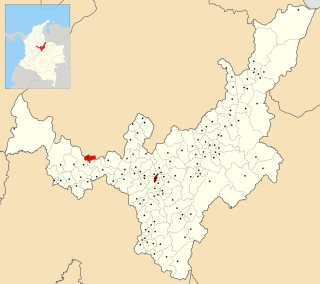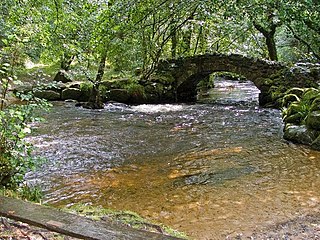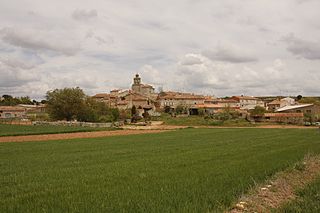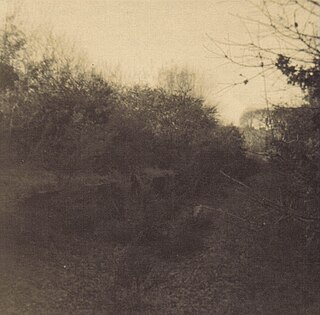
Teignbridge is a local government district in Devon, England. Its council is based in the town of Newton Abbot. The district also includes the towns of Ashburton, Buckfastleigh, Dawlish, Kingsteignton and Teignmouth, along with numerous villages and surrounding rural areas. Teignbridge contains part of the south Devon coastline, including the Dawlish Warren National Nature Reserve. Some of the inland western parts of the district lie within the Dartmoor National Park. It is named after the old Teignbridge hundred.

Ilsington is a village and civil parish situated on the eastern edge of Dartmoor, Devon, England. It is one of the largest parishes in the county, and includes the villages of Ilsington, Haytor Vale, Liverton and South Knighton. The parish is surrounded, clockwise from the north, by the parishes of Bovey Tracey, Teigngrace, Newton Abbot, Ogwell, Bickington, Ashburton, Widecombe-in-the-Moor and Manaton. In 2001 the population of the parish was 2,444, greatly increased from the 886 residents recorded in 1901. The parish is represented in parliament by Mel Stride, as part of the Central Devon constituency.

Wootton Creek is a tidal estuary that flows into the Solent on the north coast of the Isle of Wight. The estuary has also been known in the past as "Fishbourne Creek", "Wootton River" and "Wootton Haven".

Belstone is a small village and civil parish in the West Devon District of Devon, England.

Dengie is a peninsula in Essex, England, that once formed a hundred of the same name . The peninsula is formed by the River Crouch to the south, the Blackwater to the north, both of which are tidal, and the North Sea to the east. The eastern part of the peninsula is marshy and forms the Dengie Marshes.

Tununguá is a town and municipality in Boyacá Department, Colombia, part of the subregion of the Western Boyacá Province. Tununguá is situated in the Eastern Ranges of the Colombian Andes at a relatively low altitude of 1,246 metres (4,088 ft). The municipality borders the department of Santander in the north and east and the Boyacá municipalities Pauna and Briceño (south).

Tinker's Bubble is an intentional community located at Norton Covert in Little Norton near Yeovil in south Somerset, England. It was established in 1994 on 40 acres (160,000 m2) of land consisting of about 20 acres (81,000 m2) of woodland as well as orchards and pasture.

El Cerro de Andévalo is a town and municipality located in the province of Huelva, Spain. According to the 2005 census, the municipality has a population of 2,636 inhabitants.
Zaio is a municipality located in the province of Nador in northeastern Morocco. In 2014 Zaio had a total population of 35,806.

Tedburn St Mary is a village and civil parish in the Teignbridge district of Devon, England, approximately 8 miles west of Exeter. It has a population of approximately 1500. The village is the principal population centre of the electoral ward called Teignbridge North. The population of the ward at the 2011 census is 2,715.

Finch Foundry is a 19th-century water-powered forge situated in the village of Sticklepath near Okehampton, Devon, England. It was originally used to produce agricultural and mining hand tools and at its peak produced around 400 edge-tools a day. It remained an active foundry until 1960 when the roof collapsed and has been a National Trust property since 1994. It contains examples of a tilt hammer, drop hammer, and shear hammer all powered by water wheels. The Trust maintains the forge in working order and demonstrations of the tools are given.

The River Bovey rises on the eastern side of Dartmoor in Devon, England, and is the largest tributary to the River Teign. The river has two main source streams, both rising within a mile of each other, either side of the B3212 road between Moretonhampstead and Postbridge, before joining at Jurston.

Cheriton Bishop is a village and civil parish situated on the northern borders of Dartmoor National park between Exeter and Okehampton, in Devon, England. The population at the 2011 Census was 652. The history of the settlement can be traced back over a thousand years when the old village centre was established as a commercial centre for the local farming community.

Lustleigh station was on the Moretonhampstead and South Devon Railway serving the village of Lustleigh, Devon, England.

Fontioso is a municipality located in the province of Burgos, Castile and León, Spain. According to the 2004 census (INE), the municipality has a population of 67 inhabitants.

The Craven Fault System is the name applied by geologists to the group of crustal faults in the Pennines that form the southern edge of the Askrigg Block and which partly bounds the Craven Basin. Sections of the system's component faults which include the North, Middle and South Craven faults and the Feizor Fault are evident at the surface in the form of degraded faults scarps where Carboniferous Limestone abuts millstone grit. The fault system is approximately coincident with the southwestern edge of the Yorkshire Dales National Park and the northeastern edge of the Bowland Fells.

Majadas de Tiétar is a municipality in the province of Cáceres and autonomous community of Extremadura, Spain. The municipality covers an area of 52 square kilometres (20 sq mi) and as of 2011 had a population of 1352 people.

Pullabrook Halt was a railway station opened in 1931 by the Great Western Railway to serve the hamlet of Pullabrook that lies between Bovey Tracey and Lustleigh in West Devon, England. Opened as Hawkmoor Halt after Hawkmoor Hospital, originally known as Hawkmoor County Sanatorium, a specialist hospital founded in 1913 as a pulmonary tuberculosis sanatorium. It was renamed Pullabrook Halt by the British Railways in 1955, a few years before closure.

West Dean Woods is a 16.3-hectare (40-acre) biological Site of Special Scientific Interest north of West Dean in West Sussex. It is managed by the Sussex Wildlife Trust.


















